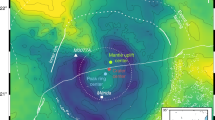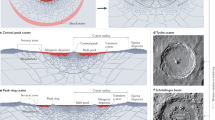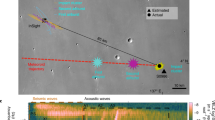Abstract
Impact craters are observed on the surfaces of all rocky planets and satellites in our Solar System1; some impacts on Earth, such as the Cretaceous/Tertiary one that formed the Chicxulub impact crater2,3, have been implicated in mass extinctions4,5,6,7,8,9,10,11,12. The direction and angle of the impact—or its trajectory—is an important determinant of the severity of the consequent environmental damage, both in the downrange direction (direction bolide travels) and in the amount of material that enters the plume of material vaporized on impact2,13,14,15. The trajectory of the Chicxulub impact has previously been inferred largely from asymmetries in the gravity anomalies over the crater2,3. Here, we use seismic data to image the Chicxulub crater in three dimensions and demonstrate that the strong asymmetry of its subsurface correlates with significant pre-existing undulations on the end-Cretaceous continental shelf that was the site of this impact. These results suggest that for rocky planets, geological and geomorphological heterogeneities at the target site may play an important role in determining impact crater structure, in addition to impact trajectories. In those cases where heterogeneous targets are inferred, deciphering impact trajectories from final crater geometries alone may be difficult and require further data such as the distribution of ejecta.
This is a preview of subscription content, access via your institution
Access options
Subscribe to this journal
Receive 12 print issues and online access
$259.00 per year
only $21.58 per issue
Buy this article
- Purchase on Springer Link
- Instant access to full article PDF
Prices may be subject to local taxes which are calculated during checkout




Similar content being viewed by others
References
Melosh, H. J. Impact Cratering: A Geologic Process (Oxford Univ. Press, New York, 1989).
Schultz, P. H. & D’Hondt, S. Cretaceous-Tertiary (Chicxulub) impact angle and its consequences. Geology 24, 963–967 (1996).
Hildebrand, A. R. et al. Mapping Chicxulub crater structure with gravity and seismic reflection data. Geol. Soc. Lond. Spec. Pub. 140, 177–193 (1998).
Alvarez, L. W., Alvarez, W., Azaro, F. & Michel, H. V. Extraterrestrial cause for the Cretaceous–Tertiary extinction. Science 208, 1095–1108 (1980).
Melosh, H. J., Schneider, N. M., Zahnle, K. J. & Latham, D. Ignition of global wildfires at the K/T boundary. Nature 343, 251–254 (1990).
MacLeod, K. G., Whitney, D. L., Huber, B. T. & Koeberl, C. Impact and extinction in remarkably complete Cretaceous-Tertiary boundary sections from Demerara Rise, tropical western North Atlantic. GSA Bull. 119, 101–115 (2007).
Pierazzo, E., Kring, D. A. & Melosh, H. J. Hydrocode simulation of the Chicxulub impact event and the production of climatically active gases. J. Geophys. Res. 103, 28607–28625 (1998).
Pope, K. O., Baines, K. H., Ocampo, A. & Ivanov, B. A. Energy, volatile production, and climatic effects of the Chicxulub Cretaceous/Tertiary impact. J. Geophys. Res. 102, 21645–21664 (1997).
Ivanov, B. A. et al. Degassing of sedimentary rocks due to Chicxulub impact: Hydrocode and physical simulations. Geol. Soc. Am. Spec. Pap. 307, 125–140 (1996).
Kring, D. A. & Durda, D. D. Trajectories and distribution of material ejected from the Chicxulub impact crater: Implications for postimpact wildfires. J. Geophys. Res. 107 (2002) (doi:10.1029/2001JE001532).
Pierazzo, E. Assessing atmospheric water injection from oceanic impacts. Lunar Planet. Sci. XXXVI, 1987 (2005).
Hildebrand, A. R. et al. A possible Cretaceous–Tertiary boundary impact crater on the Yucatan peninsula, Mexico. Geology 19, 867–871 (1991).
Schultz, P. H. Effect of impact angle on vaporization. J. Geophys. Res. 101, 21117–21136 (1996).
Pierazzo, E. & Melosh, H. J. Hydrocode modelling of Chicxulub as an oblique impact event. Earth Planet. Sci. Lett. 165, 163–176 (1999).
Pierazzo, E. & Melosh, H. J. Hydrocode modelling of oblique impacts: The fate of the projectile. Meteor. Planet. Sci. 35, 117–130 (2000).
Sharpton, V. L. et al. Model of the Chicxulub impact basin. Geol. Soc. Am. Spec. Pap. 307, 55–74 (1996).
Morgan, J. et al. Size and morphology of the Chicxulub impact crater. Nature 390, 472–476 (1997).
Morgan, J. & Warner, M. Chicxulub: The third dimension of a multi-ring basin. Geology 27, 407–410 (1999).
Morgan, J. V. et al. Peak-ring formation in large impact craters: Geophysical constraints from Chicxulub. Earth Planet. Sci. Lett. 183, 347–354 (2000).
Gault, D. E. & Wedekind, J. A. Experimental studies of oblique impact. Proc. Lunar Planet. Conf. 9, 3843–3875 (1978).
Morgan, J. et al. Chicxulub crater seismic survey prepares way for future drilling. Eos Trans. Am. Geophys. Union 86, 325–328 (2005).
Ames, D. E., Jonasson, I. R., Gibson, H. L. & Pope, K. O. Impact-generated hydrothermal system: Constraints from the large Paleoproterozoic Sudbury crater. Can. Geol. Surv. Canada Contr. Ser. 2003306, 55–100 (2006).
Pope, K. O., Ocampo, A. C., Kinsland, G. L. & Smith, R. Surface expression of the Chicxulub crater. Geology 24, 527–530 (1996).
Camargo-Zanoguera, A. & Suarez-Reynoso, G. Evidencia Sismica del crater impacto de Chicxulub. G. Bol. Asoc. Mex. Geof. Expl. 34, 1–28 (1994).
Christeson, G. L., Nakamura, Y., Bufler, R. T., Morgan, J. & Warner, M. Deep crustal structure of the Chicxulub impact crater. J. Geophys. Res. 106, 21751–21769 (2001).
Warner, M. et al. High-resolution images of the lower crust: Deep seismic reflections from 15–180 Hz. Tectonophysics 232, 225–237 (1994).
Lana, C., Gibson, R. & Reimold, W. U. Impact tectonics in the core of the Vredefort Dome; implications for central uplift formation. Meteor. Planet. Sci. 38, 1093–1108 (2003).
Gifford, A. W. & Maxwell, T. A. Asymmetric terracing of lunar highlands craters: Influence of pre-impact topography and structure. Proc. Lunar Planet. Conf. 10, 2597–2607 (1979).
Gifford, A. W., Maxwell, T. A. & El-Baz, F. Geology of the lunar farside crater Necho. Moon Planets 21, 25–42 (1979).
Vermeesch, P. M. Geophysical Study of the Chicxulub Impact Crater. Thesis, Imperial College London, UK, 418 p (2006).
Acknowledgements
The authors thank the Captain and Crew of the R/V Maurice Ewing for a successful cruise. Appreciation is owed to several Mexican and US colleagues onboard and on land for support during the experiment. Study financially supported by the National Science Foundation (NSF-OCE 0221101) and the Natural Environment Research Council. Manuscript support provided by Jackson School of Geosciences and Geology Foundation at UT Austin. Review by A. Wittman improved the manuscript. UTIG Contribution No. 1889 and IARC Contribution No. 2007-0951.
Author information
Authors and Affiliations
Contributions
Contributions include project planning and leadership by S.P.S.G., P.J.B., G.L.C., J.V.M., J.U.-F. and M.R.W., data acquisition by all authors, data processing by S.P.S.G., P.J.B., M.M., G.L.C. and K.M.-C. and interpretation by S.P.S.G., M.M., K.M.-C. and Z.F.P.
Corresponding authors
Supplementary information
Supplementary Information
Supplementary information for figures 1–6 (PDF 24295 kb)
Rights and permissions
About this article
Cite this article
Gulick, S., Barton, P., Christeson, G. et al. Importance of pre-impact crustal structure for the asymmetry of the Chicxulub impact crater. Nature Geosci 1, 131–135 (2008). https://doi.org/10.1038/ngeo103
Received:
Accepted:
Published:
Issue Date:
DOI: https://doi.org/10.1038/ngeo103
This article is cited by
-
Chicxulub impact winter sustained by fine silicate dust
Nature Geoscience (2023)
-
The Chicxulub impact and its environmental consequences
Nature Reviews Earth & Environment (2022)
-
Life before impact in the Chicxulub area: unique marine ichnological signatures preserved in crater suevite
Scientific Reports (2022)
-
Chicxulub Crater Joint Gravity and Magnetic Anomaly Analysis: Structure, Asymmetries, Impact Trajectory and Target Structures
Pure and Applied Geophysics (2022)
-
Imaging the Chicxulub Central Crater Zone from Large-Scale Seismic Acoustic Wave Propagation and Gravity Modeling
Pure and Applied Geophysics (2021)



